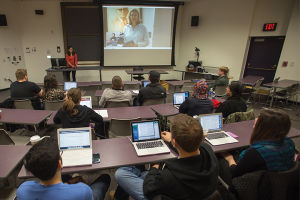Israel Studies Course Pairs University Of Maryland Students With Tel Aviv Professor
February 25, 2014

New academic partnerships between UMD and Tel Aviv University unite international students through video conferencing software.
By Erin Serpico, The Diamondback.
When university President Wallace Loh visited the Middle East in April, he returned with some new additions.
Loh signed academic partnerships with several universities in Israel and Jordan in an effort to globalize this university and strengthen its relationships with those institutions.
Almost a year after the agreement, university students are able to learn with students at Tel Aviv University through video-conference software in an Israel studies class.
“I was glad [for the collaboration] because of the connection,” said Paul Scham, visiting professor and Gildenhorn Institute for Israel Studies executive director. “I think for someone who teaches about Israel, the sense of connection is important in ways we don’t see, we don’t realize.”
As the first effort in cohesion with the agreement to globalize the classroom, an 18-person class — ISRL 359A: Israel Studies Global Classroom; Conflicts and Challenges in Israel 1948-1967 — launched this semester, allowing a professor in Tel Aviv to teach students in the city and at this university simultaneously.
Scham, Gov. Martin O’Malley and Yoram Peri (professor and Gildenhorn Institute director) were all involved in the initial collaboration. This state and Israel already have close ties economically and socially, Peri said, but on his most recent trip, O’Malley wanted to incorporate an academic tie.
“You open the door to wonderful new ideas of learning,” Peri said. “It’s the beginning of new higher education.“
While Scham and Peri organized the course on this campus and act as the facilitators, the official professor for the class is Anat Stern from Tel Aviv, who instructs from Israel.
Because Tel Aviv’s second semester did not begin until Feb. 16, the professors at this university gave in-class lectures for three classes before video conferencing began Feb. 17. The three-and-a-half hour course is not just a lecture; the second half involves a discussion-based period for students in both classrooms to interact with one another.
The students enrolled in the class at Tel Aviv University include a wide variety of international students with different backgrounds and countries of origin, Scham said.
A class and partnership like this also encourages students to visit the country, Peri said, because there are many opportunities to do so while learning about it interactively.
Junior geographical sciences major Mohamad Ibrahim has never visited Israel, but because there are several students on the campus who have, he said being in the class makes it easy for them to relate to the topic.
“It allows for better access to a lot of experts,” Ibrahim said. “ It’s an intelligent topic, and the fact that it’s taught like this is amazing.”
Peri said the partnership could be used within other disciplines or in other countries, but more intricate classes might require more preparation and research.
“This is only the beginning, but the idea is to go beyond Tel Aviv and UMD,” Peri said.
Scham said they expect to see more partnerships like this in the future, and “in five to 10 years, this will be the norm,” he said.
To read more, click here.

